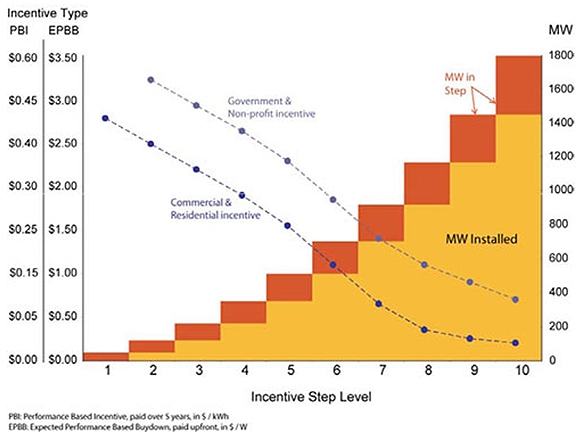California Solar Rebates
A Decade of Support for Solar
The California Solar Initiative is part of the Go Solar California campaign and builds on 10 years of state solar rebates offered to customers in California's investor-owned utility territories: Pacific Gas & Electric (PG&E), Southern California Edison (SCE), and San Diego Gas & Electric (SDG&E.) The California Solar Initiative is overseen by the California Public Utilities Commission. In January 2006, the CPUC collaborated with the Energy Commission to develop the framework of the California Solar Initiative Program through 2016.
In January 2007, the State of California launched Go Solar California, which included two new solar incentive programs, with slightly modified program requirements compared to the older programs. The Energy Commission provides incentives to energy efficient new home construction under the New Solar Homes Partnership. All other facilities in investor-owned utility territories receive rebates from the CPUC-administered program, the California Solar Initiative.
The new framework also included a major shift in the way solar incentives were calculated - away from a system that funded solar incentives based only on nameplate capacity and towards one where incentive levels are based on performance factors such as installation angle, tilt, and location. This performance framework ensures that California is generating clean solar energy and rewarding systems that can provide maximum solar generation.
The CPUC developed the program rules for the California Solar Initiative through a public rulemaking process. Among the major policy decisions made by the CPUC's rulemaking were how to organize and adjust the incentive levels, how to provide performance based incentives, how to require metering, and how to develop program rules in the form of a Program Handbook. The rulemaking also decided issues related to low income solar program development, marketing and outreach, research, development and demonstration (RD&D), program measurement and evaluation, and the Self Generation Program, which provides incentives to wind and fuel cells.
The California Solar Initiative has a budget of $2,167 million (2007-2016). The program components of the CPUC's California Solar Initiative have separate budget and administration plans. All budgets are for 10 years.
The California Solar Initiative Offers:
The California Solar Initiative offers financial incentives for solar installations based on the expected performance of a given solar installation. The expected performance is derived from the size of the solar array, and also takes into consideration the angle and location of the system installation. For larger systems, the incentive is based on the actual performance of the system over the first five years.
The incentive level available to a given project is determined by currently available incentive in each utility territory for each customer class. The CSI was designed so that the incentive level decreases over ten steps, after which it goes to $0, as the total demand for solar energy systems grows.
The CPUC divided the overall goal of 1,750 megawatts by the ten declining steps. Each step has megawatts allocated to each Program Administrator and customer class, residential and non-residential (a combination of commercial and government/non-profit). Once the total number of megawatts for each step is reached within a particular customer class, the Program Administrator moves to the next step and offers a lower incentive level for that class. Therefore, high commercial demand in SCE's territory will not lower the incentive level offered to PG&E's residential customers, and so on.
Figure 1 offers a visual explanation of the increasing megawatt installations and decreasing incentive levels over the life of the program. The orange box in each "Incentive Step Level" represents the available megawatts at that incentive value. The yellow box represents the cumulative installed megawatts as the program proceeds through the steps.
Figure 1

The California Solar Initiative pays solar consumers their incentive either all-at-once for smaller systems, or over the course of five years, for larger systems. The program's two incentive payment types are:
- Expected Performance-Based Buy-Down, or EPBB:
In 2008-9, systems smaller than 50kW in capacity can receive a one-time, up-front incentive based on expected performance, and calculated by equipment ratings and installation factors (geographic location, tilt and shading). EPBB payments are provided on a $ per watt basis. EPBB is available for systems under 30 KW after 2010. Systems eligible for EPBB can choose to opt-in to the PBI system described below. - Performance Based Incentive, or PBI:
As of January 1, 2008, all systems over 50 kW must take the PBI, and by 2010 all system over 30 kW must be on PBI. Any sized system can elect to take PBI. The PBI pays out an incentive, based on actual kWh production, over a period of five years. PBI payments are provided on a $ per kilowatt-hour basis.”
In addition to the California Solar Initiative, San Diego homeowners who go solar in 2012 can participate in the San Diego Solar Program. To learn more, click here.